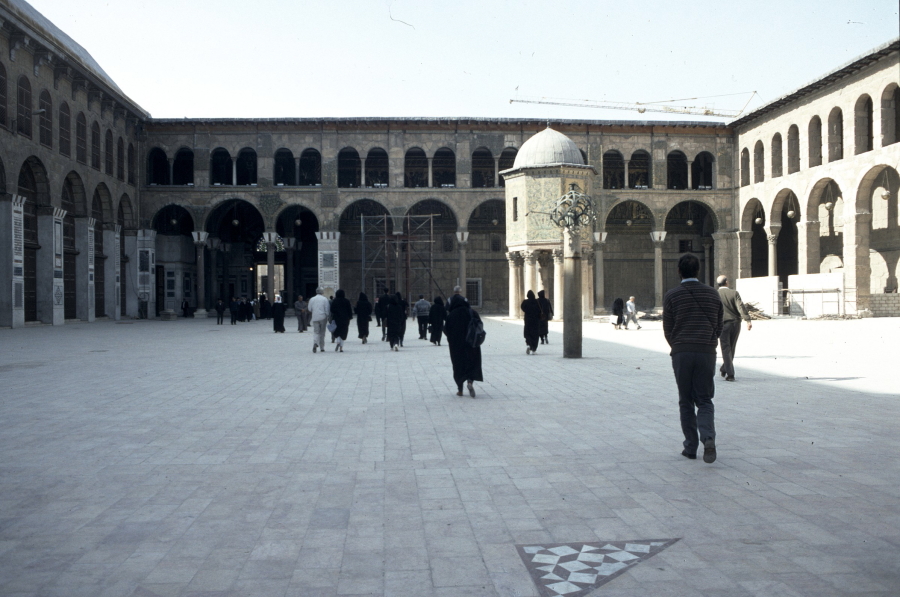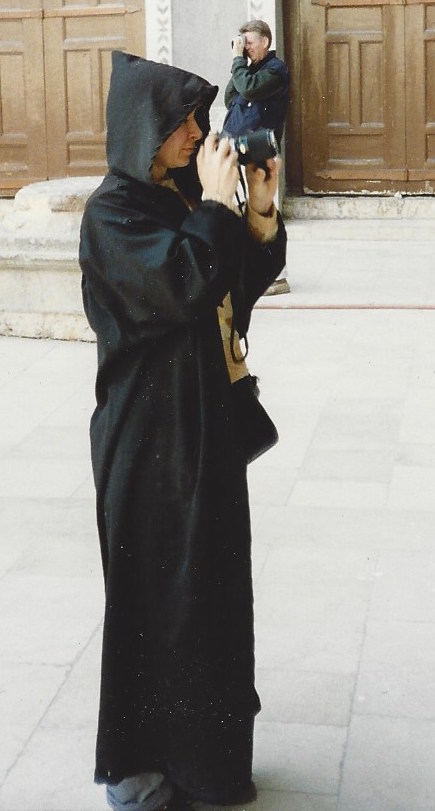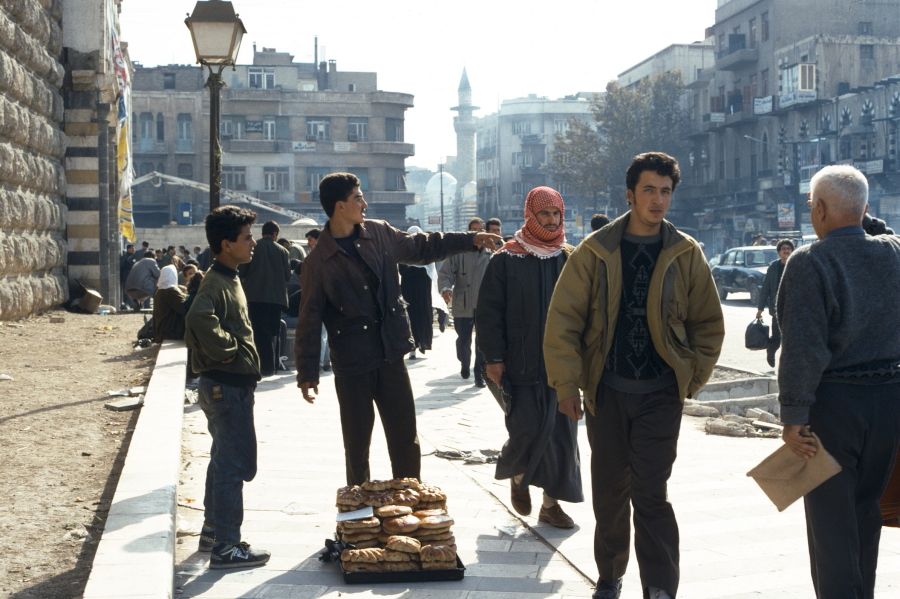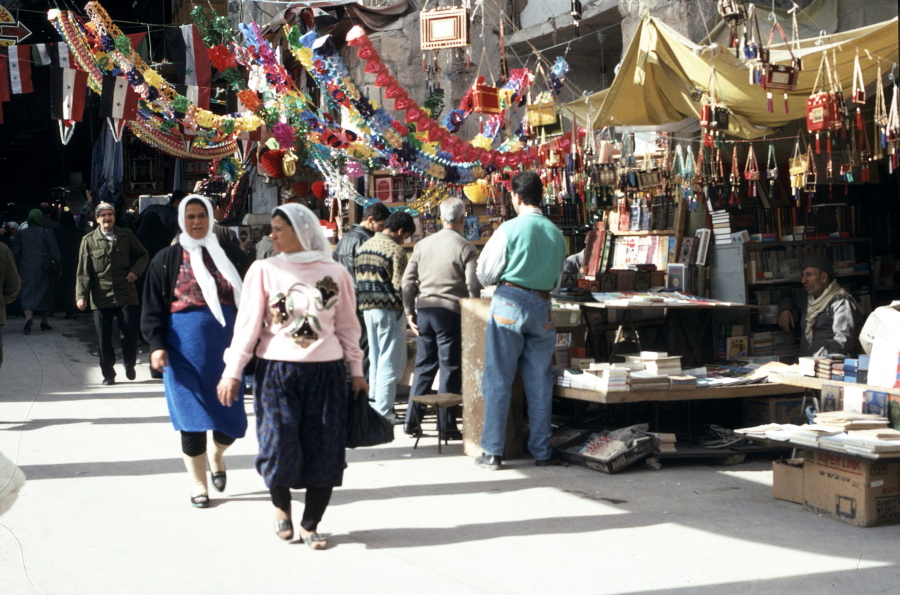Monday 29th November 1993, 11:00am to 1:00pm
We pile off the bus in Damascus and follow the guide. There is little time for dawdling. There is a lot to do and little time. We find ourselves standing looking at the mausoleum of Saladin. Saladin we are told was his title, not his name, which was Joseph son of Job. I don't go in, maybe some of our tour group spend longer at the tomb but I hurry on into the main court yard of the Umayyad Mosque. The Great Mosque.

My preconceived ideas of what a mosque would be like are overturned. I expected to see mainly men and a rather solemn, formal place but there are a lot of women - mothers and grandmothers with children going in and out of what seems more like a busy community centre. The women in our group are kitted out with long, black hooded robes, the "proper dress" required for entry. At least I can come in here, I remember when we were in Spain and I wasn't allowed in the cathedral in Toledo because I didn't have a head covering or sleeves.
 Inside it is busy. A large open space, with columns and arches, the floor covered with carpet. Some people are praying, others are walking around or sitting quietly in groups, some reading, some nursing babies. Toddlers are playing on the carpeted floor. Everyone is carrying their shoes. The guide points out that the Muslims pray facing Mecca but when this site had earlier been a church the Christian orientation of prayer was turned through 90º. I didn't catch everything the guide said, something had distracted me. The next time I was aware of him speaking he was telling us that the remains of St John were buried here, this place had been the Basilica of St John the Baptist. I wonder if John had been left to rest in peace or plundered. Saints seem to have bits of them all over the Middle East and Europe, holy relics and their miraculous powers.
Inside it is busy. A large open space, with columns and arches, the floor covered with carpet. Some people are praying, others are walking around or sitting quietly in groups, some reading, some nursing babies. Toddlers are playing on the carpeted floor. Everyone is carrying their shoes. The guide points out that the Muslims pray facing Mecca but when this site had earlier been a church the Christian orientation of prayer was turned through 90º. I didn't catch everything the guide said, something had distracted me. The next time I was aware of him speaking he was telling us that the remains of St John were buried here, this place had been the Basilica of St John the Baptist. I wonder if John had been left to rest in peace or plundered. Saints seem to have bits of them all over the Middle East and Europe, holy relics and their miraculous powers.
It didn't seem right to take photographs of the people inside, it felt like being in someone's private space.
It was time to go. Lunch would be waiting. We leave the mosque and follow the guide through the covered shopping streets. The souks are crowded and the small shops lining each side are packed with a multiplicity of assorted goods, almost all brightly coloured. I notice a great many shops selling children's wear. The guide had told us the population was increasing rapidly and we have seen a lot of children in our short time here. Everything seems to revolve around the children and if the shops in the Souks are any indication their families like to dress them well, in bright and cheerful clothes.
The shop owners and traders quickly spot a group of tourists and waste no time in trying to win our business. Some call to us in English, others step out holding their goods aloft, yet others call and beckon, some offer us samples of their nuts or fruit or spices. I am sure my daughter would love one of the ornate dresses, she'd think they were bridesmaids' dresses, fit for a princess, but we have no time to stop. In the crowded souk we are concentrating on following the guide. We do not want to get lost or miss lunch. Besides it is still only the second full day and I'll have to see how much money I have left nearer the end of the trip. I'm sure we will get more opportunities for shopping.
I lose sight of the guide for a few seconds. If we get separated we are to go to Saladin's statue, a new statue recently unveiled by Hafez Assad, to mark the 800th anniversary of his death, but I don't want the embarrassment of being the one to get lost. I search around and see the guide turing into what looks like a narrow alley way. I catch up and follow him. It isn't an alley way but the entrance to a "snack bar".
On one side people are standing around eating; on the other side men are pounding, kneading and flattening bread, adding toppings, baking them over a fire. We pass the diners and the bakers and at the end of the passage follow the guide up a flight of stairs, we reach the next floor and weave through more diners tucking into the salads, dips, bread and barbecued meat we'd already come to expect. Syrian food is delicious. Another flight of stairs and we arrive on the top floor. The ceiling is carpet, it has the feeling of a tent. Is the space reserved for foreign tourists, something special maybe?
The food is not disappointing. Once again excellent but once again far too much. If this is a light lunch I can't imagine what the Syrians think is a large meal. Do they really have meals that would out do the average Texan steak house or is this another "boast" to show the plentiful bounty of the land when the reality is different? We are carefully taken from place to place and while we see the ordinary every day goings on in the Souk and around the town, the farmers and their tractors across large flat fields, the women buying their flat bread and carrying it through the streets inside the walls of Bosra, will we really learn much about the reality of life in Syria for the ordinary citizen, if indeed there is such a thing as "ordinary". We'll be here for a week. Just visitors on a whistle-stop tour, skimming the surface yet going away experts compared to our neighbours back home.
In addition to the usual lunch time fare there is what the guide described as Syrian pizza. A flat bread, sort of cross between pizza and pitta, topped with a spicy mince lamb meat, which I later discovered was a popular Syrian dish, laham bajine. This is what we had seen being made on the ground floor and presumably the speciality of the house and the reason it had been selected for our lunch.
My belly is already full to bursting when I realise that rather than an apple for dessert we are being served a real pudding. Some sort of pistachio cheese cake: curd cheese or, maybe and, cream on a small pikelet base and topped with fresh, chopped pistachios. Absolutely delicious. The pikelet base is almost identical to our pikelets at home, just a bit smaller but if you like pistachios then Syria is the place to eat them.
Usually we are served tea after the meal but now we are given a glass of cola. The cafe has run out of drinking water. The guide laughs: we have four cases of mineral water on our coach but there is a shortage today across Damascus. The water deliveries have failed to arrive. I don't like cola but drink a little.
Time waits for no man and that is certainly true on this trip. We are soon hurried out of the cafe, down the flights of stairs, back past the men making the pizzas and out onto the street. The guide shepherds us towards the main road en route back to the bus. A few of the group stop and call to us. They have seen a shop selling cakes and pastries and think it would be nice to buy some for eating on our long coach journeys. There are dozens of variations on the theme of pistachios: baklava, biscuits, pastries. The guide, taking his duty to inform us about Syria seriously, stops and tells us that pistachios are a major Syrian crop, along with cotton, which they are now exporting as demand elsewhere and their output grows. He goes into the shop and comes out with a large box of assorted baklavas and pasties. We are in for an afternoon treat.
Our route to the bus takes us through more souks. It it too dark for me to take quick snap shot photos and although the guide isn't hassling us to rush I don't have time to mess around trying to get the camera settings right for the light conditions. It would be nice to have more time, but maybe it will come another day. I content myself with street pictures where the light conditions are less challenging.

Back on the bus and we're off to Palmyra. Not yet 24 hours in Syria and yet we have seen so much. Damascus, apart from the many women and the communal atmosphere in the mosque, had been much as I expected, but Bosra had been amazing. I didn't know such places existed. Almost everyone I'd seen working "intra-murals" had been engaged on a restoration project, rebuilding and reconstructing pillars and streets from the ruins. Our guide, being amongst other things an archeologist, was very interested in the projects and had enthused over the plans to restore the ancient splendour. While acknowledging that some would prefer the money to be spent on modern services and facilities he thought there had to be a balance. The projects were important because they would bring in tourists. Syria was part of the "cradle of civilisation", they were looking after it and repairing it. It would bring in more visitors from around the world to see their heritage and discover the friendliness of the Syrian people.
I think back over our day so far and try to imagine what Bosra might be like in twenty years: would the inhabitants be living on tourism? Would the Americans have opened a MacDonald's? Hopefully, not the latter!
